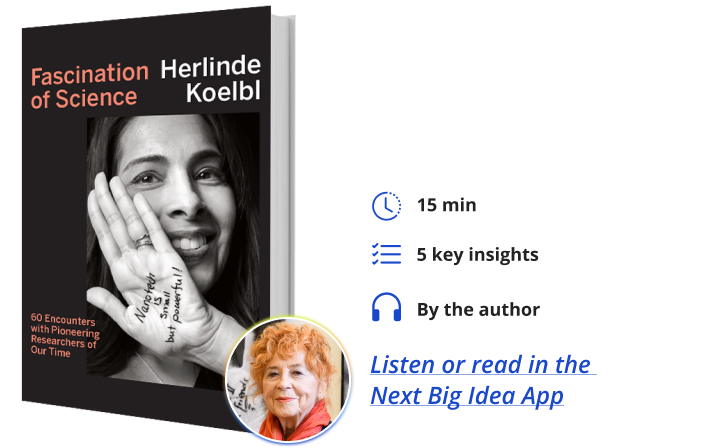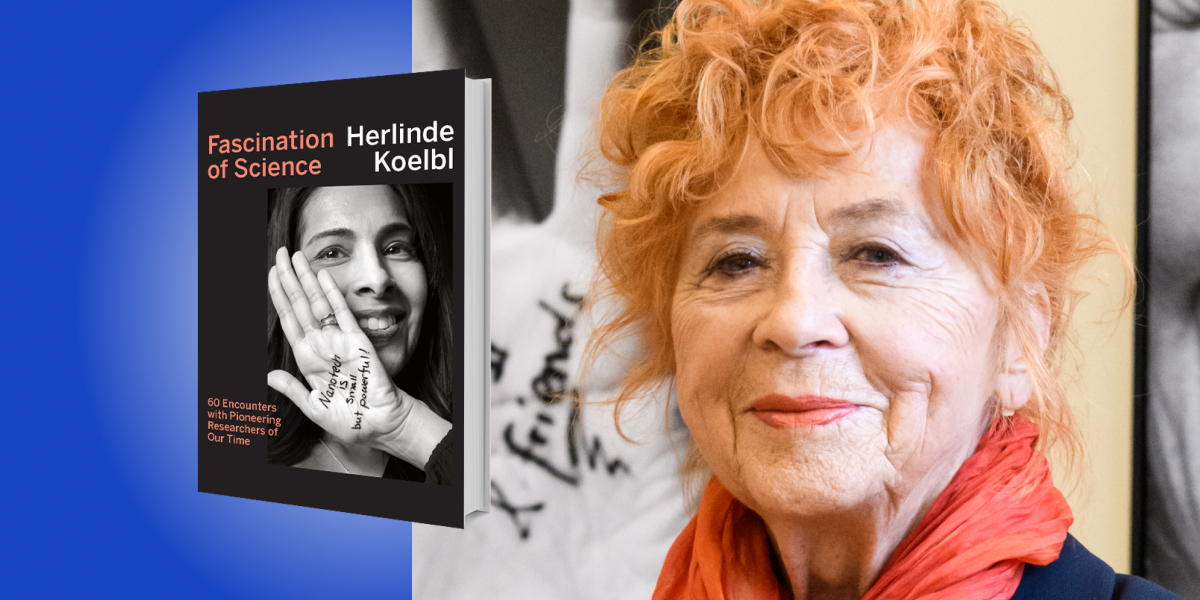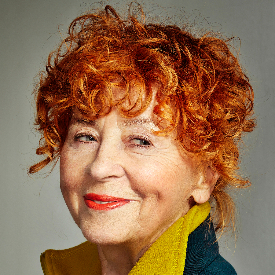Herlinde Koelbl is a photographic artist, author, and documentary filmmaker. She has published more than a dozen photography books, including Jewish Portraits, Targets, and Angela Merkel Portraits 1991–2021. She has received numerous awards for her work, including the Dr. Erich Salomon Prize in 2001.
Below, Herlinde shares 5 key insights from her new book, Fascination of Science: 60 Encounters with Pioneering Researchers of Our Time. Listen to the audio version—read by Herlinde herself—in the Next Big Idea App.

1. Photography can humanize the world’s best scientists.
I once wondered if the current prejudices about scientists are true. Are they really so different from us? It has been quite a discovery for me to see in my interviews with them how colorful and sparkling their character is. They spoke openly and vividly as they talked with me about their way to the top.
I visited academic hotspots of scientific research worldwide, interviewing and photographing approximately 60 top international scientists and Nobel Laureates. Their different biographies show that science is a global subject in which people can follow their own course independently of their origins or character if they are driven by a common interest: curiosity and a thirst for knowledge.
I choose mostly Nobel Laureates and other very successful scientists, as they could be role models for the young generation. One of my main intentions in creating this project was to spark an interest in science, especially in young people. Sometimes they tend to choose to study economics or IT, because that seems to be the fastest route to money. They could—or better should—study science. That is our future, our most important resource.
The world of natural science is so large and diverse and exciting! With natural science, you can change the future of the world. And this is a dream many kids have. They could fulfill this dream in science. The scientist David Avnir put it in a nutshell: “After a successful day you may have changed the world because you have created new knowledge.”
2. Scientists are also storytellers.
Often scientists are photographed in their lab coats surrounded by their instruments. I thought this is boring and I did not want to produce pictures like that. Therefore, I created a very special idea for the scientists. I wanted to bring their personality and their knowledge together in one picture. So how to do this?
I asked them to write the formula of their most important research or their philosophy on their hand. I did not give orders. The only instruction that was mandatory was to put their hand close to their face. They could do whatever they wanted. This has a playful element that reflects the child-like urge to do research, which researchers must never lose if they want to be successful.
“The hands are storytellers.”
Most of my subjects liked the idea very much. It was new to them. Without hesitation, they knew almost immediately what they would bring into the world. That showed me how passionate they are about their topic and how focused they are on it. Through this, I could create very lively and eye-catching pictures. You might have never seen these scientists like this before.
The hands are storytellers. You watch the hand, and you try to remember some things you have learned at school in physics or chemistry. Or you try to figure out at least what branch of science you are seeing on the hand. One very special quote is from the Nobel Laureate Emmanuelle Charpentier, who wrote her life philosophy on her hand: Always try to be the best of yourself!
3. Scientific research is like climbing Mount Everest.
The scientists are driven by what they are doing, and they get a lot of satisfaction out of it. But our idea of a “eureka moment is fairly romantic. Doing research is more like climbing Mount Everest.” This is a comment by one of the researchers.
Just like climbing Mount Everest, the life of a scientist may be sometimes quite draining and exhausting with long working days and hardly any weekends. But just like the name of the mountain climber who climbed a summit for the very first time, the name of scientists that made groundbreaking discoveries will also always be remembered. They made history and we learn about them at school. Theories are named after them, streets, buildings and organizations as well. The biggest reward for scientists who reach the summit is maybe this feeling of euphoria, which is elevating and priceless. They will never forget it. It will be indelibly burned into their hearts.
“It is important to stay open-minded.”
If the scientists see their hypotheses confirmed by the result of their research, and the outcome is a medication that helps to cure a severe disease, it is absolutely rewarding. “It is like you are playing chess against God and you try to outsmart him and evolution, which is not easy,” says Nobel Laureate Aaron Ciechanover.
Sometimes scientists might feel a bit desperate, because they think, they have failed. After the first disappointment and after taking a closer, more analytical look, they might even see that the so-called failure shows a new discovery, just by accident. It is important to stay open-minded.
“Learn through failure!” Bruce Alberts wrote on his hand.
4. Many scientists share the trait of curiosity.
The British Nobel Laureate Sir Paul Nurse told me: “Becoming a scientist is a vocation”. Once you have tried to gain knowledge, you’re drawn to it again and again. It’s like a pull. Successful scientists have many character traits in common.
First of all, they have an almost impossible mixture of perseverance and flexibility. You need patience and staying power to achieve scientific breakthroughs. On this long road, they have many moments of satisfaction, and this keeps them going. It is their inborn curiosity that drives them on and on.
Scientists have to have an endless and enormous curiosity to understand their surroundings, and enthusiasm to learn more and more. On the one hand, you have to acquire a solid background in the existing knowledge in order to be part of the system; on the other hand, you should be able to think outside of the box, to create new ideas.
“You need patience and staying power to achieve scientific breakthroughs.”
One scientist told me this story: “I was born a scientist. When I was three years old, there was a food shortage in Israel. Our family had one chicken, that lay one egg a day. My task was to eat that egg. I understood that the chicken was extremely important to the well-being of the family. Therefore, I took a feather, planted it in the ground, and watered it, so that a new chicken would grow. This was my first scientific experiment and of course, it failed. But it became obvious early on that science was what I wanted to do. It came from within.”
5. There is a deep connection between science and art.
Art and science are driven by the human curiosity to understand the world. And another striking similarity is the creative process. Artists and scientists alike engage in a process of experimentation. Thinking out of the box and pushing boundaries, free-thinking without borders, are the main ingredients for the creative and innovative process. Art and science have many characteristics in common: curiosity, perseverance, creativity, courage, dedication, and discipline. Both scientists and artists can change the whole world with their creations.
The best example of how good art and science are compatible is Leonardo Da Vinci. He was a master of both disciplines. He was able to think the unthinkable, be courageous, and follow his dreams. Leonardo’s mindset was deeply influenced by the idea of the unity of science and art. For him, science and art were not separate domains. They stimulate each other and help to make the world a better place.
To listen to the audio version read by author Herlinde Koelbl, download the Next Big Idea App today:





























